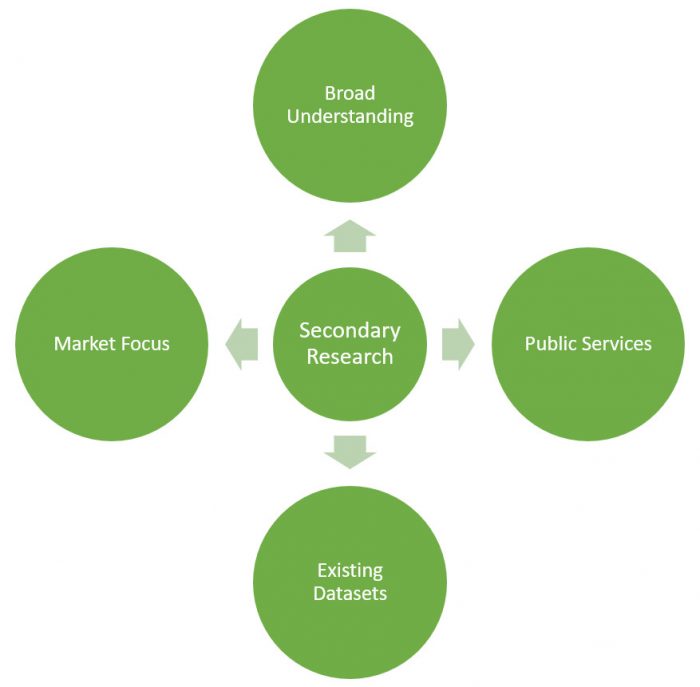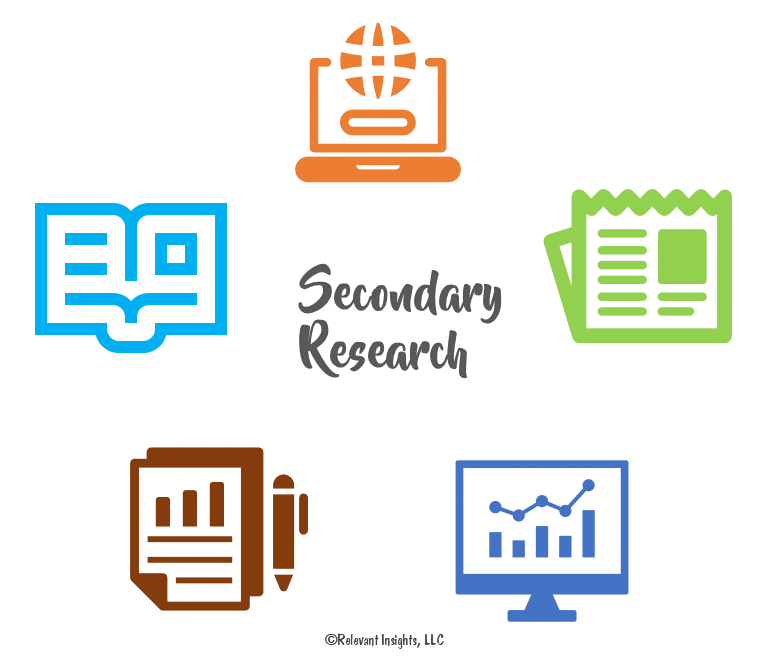Advantages of Secondary Research
Secondary research refers to the use of existing data to answer research questions or solve research problems. There are many situations where taking this approach can be of benefit, and in this article, we outline some of the key features and types of secondary research and why there are advantages to following this route rather than gathering your own data.


Secondary Research design and types
Secondary research, also known as desk research, is undertaken by collating existing data online or from journals, books and public sources such as government archives and libraries. The design of the research means that the researcher pulls together a range of different data samples and collates them in a systematic way to achieve their research conclusions. The aim is to examine and evaluate established patterns from previous (or a priori) sources and apply these to their own research context.
In most cases the secondary researchers are reliant on data that was previously gathered from primary research and can be used to evaluate and identify gaps in existing knowledge. As a result, secondary research studies are frequently the foundation for subsequent primary research works which examine these identified gaps.
Common Secondary Research Sources
Once you understand that secondary research requires the assimilation and collation of data from potentially varied sources, then you can recognise that this new pool of data can deliver potentially new insights. Common sources of secondary data include online sources, libraries, archives, commercial and organisational reports as well as peer-reviewed journals and textbooks.
Online data
Online data gathering is a highly popular method for secondary research, which gives access to a high volume of both free and paid sources that can be easily gathered by the researcher. Indeed, it can be suggested that online sources bring together, at the click of a button, all the other potential sources of data for secondary research.
Government and Other Archives
Useful research can be found in government archives which are considered verifiable and trustworthy, and as a result can be used to identify insights on a range of research contexts. Care should be taken however not to try and access classified information.
Libraries and Educational Institutions
Public and private libraries are highly valuable sources of information. In particular many hold copies of dissertations, donated by researchers and students. In addition, libraries are an excellent source for commercial research and business reports. Similar to libraries are educational institutions which frequently have copies of a range of primary research that they may be willing to share to further knowledge and understanding in particular area.
Types of Secondary Research
Similar to primary research, secondary research may also be qualitative or quantitative, or a mix of both approaches. Qualitative secondary data is generally interviews or focus groups which can be used to gain more in-depth insights into a research problem or business question. Quantitative data in contrast is focused on gathering statistical data from surveys, questionnaires and business trends.
The biggest advantage of secondary research is that in most cases the data is easy to access, particularly when gathering data from online sources. More traditional secondary research sources such as libraries or government archives are also easy to access. This saves the researcher a great deal of time and allows for a potentially wider dataset to be gathered.
Equally important to many researchers is that secondary research is cost-effective, as there is no direct data collection from a cohort.
A major value in utilising secondary research is that it allows a researcher at an early stage of investigation to identify knowledge gaps in a study area. In other words, it can be used to present initial thoughts before embarking on a longer study and the collection of primary data.
Alongside identification of knowledge gaps, undertaking secondary research at the outset of an investigation can potentially identify that the planned work has already been undertaken and the information the researcher hoped to gain is already available. This can eliminate the need for undertaking time-intensive and costly primary research. Read about the disadvantages of primary research .
An additional potential benefit of utilising secondary research is that in many cases, the data is already in the public domain and thus permission for usage or consent from participants is not required. In addition, provided the secondary data is used appropriately, there is frequently less concerns about potential ethical violations in the conduct of the research.
When should I use secondary research?
There are a number of scenarios when secondary research may be viable:
- When the purpose of the proposed work is to identify gaps in knowledge.
- When the study to be undertaken is building on an existing work and seeks not to find new outcomes but is designed to look at new trends and relationships in existing data sets.
- When the researcher has an existing view on what their outcomes may be and is aware that there is authentic data already available (for example, industry or government reports which are viewed as credible sources).
- There has been a recent data collection of information that is applicable to the study aims and it would not be economical or viable to collect new data. This is a major advantage of using secondary research, particularly in existing fields of study.
Whatever your research question or problem is, in most cases there is a wide body of knowledge and potential datasets that can be collated and used to provide initial responses. So, if you’re looking for easy-to-access data for your essay or dissertation, secondary research may be the right option for you!
- Login to Survey Tool Review Center
Secondary Research Advantages, Limitations, and Sources
Summary: secondary research should be a prerequisite to the collection of primary data, but it rarely provides all the answers you need. a thorough evaluation of the secondary data is needed to assess its relevance and accuracy..
5 minutes to read. By author Michaela Mora on January 25, 2022 Topics: Relevant Methods & Tips , Business Strategy , Market Research

Secondary research is based on data already collected for purposes other than the specific problem you have. Secondary research is usually part of exploratory market research designs.
The connection between the specific purpose that originates the research is what differentiates secondary research from primary research. Primary research is designed to address specific problems. However, analysis of available secondary data should be a prerequisite to the collection of primary data.
Advantages of Secondary Research
Secondary data can be faster and cheaper to obtain, depending on the sources you use.
Secondary research can help to:
- Answer certain research questions and test some hypotheses.
- Formulate an appropriate research design (e.g., identify key variables).
- Interpret data from primary research as it can provide some insights into general trends in an industry or product category.
- Understand the competitive landscape.
Limitations of Secondary Research
The usefulness of secondary research tends to be limited often for two main reasons:
Lack of relevance
Secondary research rarely provides all the answers you need. The objectives and methodology used to collect the secondary data may not be appropriate for the problem at hand.
Given that it was designed to find answers to a different problem than yours, you will likely find gaps in answers to your problem. Furthermore, the data collection methods used may not provide the data type needed to support the business decisions you have to make (e.g., qualitative research methods are not appropriate for go/no-go decisions).
Lack of Accuracy
Secondary data may be incomplete and lack accuracy depending on;
- The research design (exploratory, descriptive, causal, primary vs. repackaged secondary data, the analytical plan, etc.)
- Sampling design and sources (target audiences, recruitment methods)
- Data collection method (qualitative and quantitative techniques)
- Analysis point of view (focus and omissions)
- Reporting stages (preliminary, final, peer-reviewed)
- Rate of change in the studied topic (slowly vs. rapidly evolving phenomenon, e.g., adoption of specific technologies).
- Lack of agreement between data sources.
Criteria for Evaluating Secondary Research Data
Before taking the information at face value, you should conduct a thorough evaluation of the secondary data you find using the following criteria:
- Purpose : Understanding why the data was collected and what questions it was trying to answer will tell us how relevant and useful it is since it may or may not be appropriate for your objectives.
- Methodology used to collect the data : Important to understand sources of bias.
- Accuracy of data: Sources of errors may include research design, sampling, data collection, analysis, and reporting.
- When the data was collected : Secondary data may not be current or updated frequently enough for the purpose that you need.
- Content of the data : Understanding the key variables, units of measurement, categories used and analyzed relationships may reveal how useful and relevant it is for your purposes.
- Source reputation : In the era of purposeful misinformation on the Internet, it is important to check the expertise, credibility, reputation, and trustworthiness of the data source.
Secondary Research Data Sources
Compared to primary research, the collection of secondary data can be faster and cheaper to obtain, depending on the sources you use.
Secondary data can come from internal or external sources.
Internal sources of secondary data include ready-to-use data or data that requires further processing available in internal management support systems your company may be using (e.g., invoices, sales transactions, Google Analytics for your website, etc.).
Prior primary qualitative and quantitative research conducted by the company are also common sources of secondary data. They often generate more questions and help formulate new primary research needed.
However, if there are no internal data collection systems yet or prior research, you probably won’t have much usable secondary data at your disposal.
External sources of secondary data include:
- Published materials
- External databases
- Syndicated services.
Published Materials
Published materials can be classified as:
- General business sources: Guides, directories, indexes, and statistical data.
- Government sources: Census data and other government publications.
External Databases
In many industries across a variety of topics, there are private and public databases that can bed accessed online or by downloading data for free, a fixed fee, or a subscription.
These databases can include bibliographic, numeric, full-text, directory, and special-purpose databases. Some public institutions make data collected through various methods, including surveys, available for others to analyze.
Syndicated Services
These services are offered by companies that collect and sell pools of data that have a commercial value and meet shared needs by a number of clients, even if the data is not collected for specific purposes those clients may have.
Syndicated services can be classified based on specific units of measurements (e.g., consumers, households, organizations, etc.).
The data collection methods for these data may include:
- Surveys (Psychographic and Lifestyle, advertising evaluations, general topics)
- Household panels (Purchase and media use)
- Electronic scanner services (volume tracking data, scanner panels, scanner panels with Cable TV)
- Audits (retailers, wholesalers)
- Direct inquiries to institutions
- Clipping services tracking PR for institutions
- Corporate reports
You can spend hours doing research on Google in search of external sources, but this is likely to yield limited insights. Books, articles journals, reports, blogs posts, and videos you may find online are usually analyses and summaries of data from a particular perspective. They may be useful and give you an indication of the type of data used, but they are not the actual data. Whenever possible, you should look at the actual raw data used to draw your own conclusion on its value for your research objectives. You should check professionally gathered secondary research.
Here are some external secondary data sources often used in market research that you may find useful as starting points in your research. Some are free, while others require payment.
- Pew Research Center : Reports about the issues, attitudes, and trends shaping the world. It conducts public opinion polling, demographic research, media content analysis, and other empirical social science research.
- Data.Census.gov : Data dissemination platform to access demographic and economic data from the U.S. Census Bureau.
- Data.gov : The US. government’s open data source with almost 200,00 datasets ranges in topics from health, agriculture, climate, ecosystems, public safety, finance, energy, manufacturing, education, and business.
- Google Scholar : A web search engine that indexes the full text or metadata of scholarly literature across an array of publishing formats and disciplines.
- Google Public Data Explorer : Makes large, public-interest datasets easy to explore, visualize and communicate.
- Google News Archive : Allows users to search historical newspapers and retrieve scanned images of their pages.
- Mckinsey & Company : Articles based on analyses of various industries.
- Statista : Business data platform with data across 170+ industries and 150+ countries.
- Claritas : Syndicated reports on various market segments.
- Mintel : Consumer reports combining exclusive consumer research with other market data and expert analysis.
- MarketResearch.com : Data aggregator with over 350 publishers covering every sector of the economy as well as emerging industries.
- Packaged Facts : Reports based on market research on consumer goods and services industries.
- Dun & Bradstreet : Company directory with business information.
Related Articles
- What Is Market Research?
- Step by Step Guide to the Market Research Process
- How to Leverage UX and Market Research To Understand Your Customers
- Why Your Business Needs Discovery Research
- Your Market Research Plan to Succeed As a Startup
- Top Reason Why Businesses Fail & What To Do About It
- What To Value In A Market Research Vendor
- Don’t Let The Budget Dictate Your Market Research Approach
- How To Use Research To Find High-Order Brand Benefits
- How To Prioritize What To Research
- Don’t Just Trust Your Gut — Do Research
- Understanding the Pros and Cons of Mixed-Mode Research
Subscribe to our newsletter to get notified about future articles
Subscribe and don’t miss anything!
Recent Articles
- How AI Can Further Remove Researchers in Search of Productivity and Lower Costs
- Re: Design/Growth Podcast – Researching User Experiences for Business Growth
- Why You Need Positioning Concept Testing in New Product Development
- Why Conjoint Analysis Is Best for Price Research
- The Rise of UX
- Making the Case Against the Van Westendorp Price Sensitivity Meter
- How to Future-Proof Experience Management and Your Business
- When Using Focus Groups Makes Sense
- How to Make Segmentation Research Actionable
- How To Integrate Market Research and UX Research for Desired Business Outcomes
Popular Articles
- Which Rating Scales Should I Use?
- What To Consider in Survey Design
- 6 Decisions To Make When Designing Product Concept Tests
- Write Winning Product Concepts To Get Accurate Results In Concept Tests
- How to Use Qualitative and Quantitative Research in Product Development
- The Opportunity of UX Research Webinar
- Myths & Misunderstandings About UX – MR Realities Podcast
- 12 Research Techniques to Solve Choice Overload
- Concept Testing for UX Researchers
- UX Research Geeks Podcast – Using Market Research for Better Context in UX
- A Researcher’s Path – Data Stories Leaders At Work Podcast
- How To Improve Racial and Gender Inclusion in Survey Design

- Privacy Overview
- Strictly Necessary Cookies
This website uses cookies so that we can provide you with the best user experience possible. Cookie information is stored in your browser and performs functions such as recognising you when you return to our website and helping our team to understand which sections of the website you find most interesting and useful.
Strictly Necessary Cookie should be enabled at all times so that we can save your preferences for cookie settings.
If you disable this cookie, we will not be able to save your preferences. This means that every time you visit this website you will need to enable or disable cookies again.
- Dissertation Proofreading and Editing
- Dissertation Service
- Dissertation Proposal Service
- Dissertation Chapter
- Dissertation Topic and Outline
- Statistical Analysis Services
- Model Answers and Exam Notes
- Dissertation Samples
- Essay Writing Service
- Assignment Service
- Report Service
- Coursework Service
- Literature Review Service
- Reflective Report Service
- Presentation Service
- Poster Service
- Criminal Psychology Dissertation Topics | List of Trending Ideas With Research Aims
- Cognitive Psychology Dissertation Topics | 10 Top Ideas For Research in 2024
- Social Psychology Dissertation Topics | 10 Latest Research Ideas
- Top 10 Clinical Psychology Dissertation Topics with Research Aims
- Educational Psychology Dissertation Topics | 10 Interesting Ideas For Research
- Customer Service Dissertation Topics | List of Latest Ideas For Students
- 15 Interesting Music Dissertation Topics
- Business Intelligence Dissertation Topics | List of Top Ideas With Research Aims
- Physical Education Dissertation Topics | 15 Interesting Title Examples
- 15 Top Forensic Science Dissertation Topics with Research Aims
- Islamic Finance Dissertation Topics | List of 15 Top Ideas With Research Aims
- Dissertation Examples
- Dissertation Proposal Examples
- Essay Examples
- Report Examples
- Coursework Examples
- Assignment Examples
- Literature Review Examples
- Dissertation Topic and Outline Examples
- Dissertation Chapter Examples
- Dissertation Help
- Dissertation Topics
- Academic Library
- Assignment Plagiarism Checker
- Coursework Plagiarism Checke
- Dissertation Plagiarism Checker
- Thesis Plagiarism Checker
- Report Plagiarism Checke
- Plagiarism Remover Service
- Plagiarism Checker Free Service
- Turnitin Plagiarism Checker Free Service
- Free Plagiarism Checker for Students
- Difference Between Paraphrasing & Plagiarism
- Free Similarity Checker
- How Plagiarism Checkers Work?
- How to Cite Sources to Avoid Plagiarism?
- Free Topics
- Get a Free Quote

- Report Generating Service
- Model Answers and Exam Notes Writing
- Reflective or Personal Report Writing
- Poster Writing
- Literature Review Writing
- Premier Sample Dissertations
- Course Work
- Cognitive Psychology Dissertation Topics
- Physical Education Dissertation Topics
- 15 Top Forensic Science Dissertation Topics
- Top 10 Clinical Psychology Dissertation Topics
- Islamic Finance Dissertation Topics
- Social Psychology Dissertation Topics
- Educational Psychology Dissertation Topics
- Business Intelligence Dissertation Topics
- Customer Service Dissertation Topics
- Criminal Psychology Dissertation Topics

- Literature Review Example
- Report Example
- Assignment Example
- Coursework Example

- Coursework Plagiarism Checker
- Turnitin Plagiarism Checker
- Paraphrasing and Plagiarism
- Best Dissertation Plagiarism Checker
- Report Plagiarism Checker
- Similarity Checker
- Plagiarism Checker Free
- FREE Topics
Get an experienced writer start working
Review our examples before placing an order, learn how to draft academic papers, what are the advantages & disadvantages of secondary research.

What is Secondary Research? | Methods, Types, and Examples

Dissertation Presentation Examples| Effective Writing Techniques for Success

Secondary research, often known as a desk study, uses third parties data rather than its own. In other words, you are not the firsthand source of the information; you have no direct influence on its correctness. Also, you are unsure of the data's representativeness.
Secondary Research Methodology Dissertation Example
Primary Research Methods: A Beginner’s Guide
Even you use the original source for the latter. For example, you might survey or interview consumers for consumer research. We refer to the information gathered as primary data.
In this article, we will explore various advantages and disadvantages of secondary research and its sources to collect information to inspire and guide aspiring researchers in formulating their own research queries.
3-Step Dissertation Process!

Get 3+ Topics

Dissertation Proposal

Get Final Dissertation
Pros and cons of secondary research: a comparative analysis.
There are comparative analyzes give you a quick review of the advantages and disadvantages of secondary research.
Pros of Secondary Research Cons of Secondary Research
Is Secondary Research Really Advantageous?
Secondary research offers numerous advantages that make it a valuable tool for researchers and students. Some of the key benefits of secondary research include;
Time and Cost Efficiency
It allows researchers to leverage existing data and information, saving considerable time and resources compared to primary research . It eliminates the need for data collection from scratch, reducing costs associated with surveys, interviews, or experiments.
Wide Range of Available Data
It draws upon a vast array of sources, including academic papers , reports, books, and online databases. This wealth of existing data provides researchers with a broad range of information and perspectives to analyze and interpret.
Larger Sample Size
Secondary research often involves large sample sizes, as it draws from existing datasets that may have been collected from numerous participants or sources. This larger sample size enhances the statistical power and generalizability of research findings.
Historical and Longitudinal Analysis
Secondary research enables the examination of historical trends and long-term patterns by utilizing data collected over extended periods. This allows researchers to analyze changes over time and identify temporal patterns or relationships.
Comparative Analysis
It is one of the pros of secondary research to perform a comparative analysis of results from different studies. Comparative analysis helps you to identify the variations and consistent patterns for your particular research.
Accessibility and Availability
Research sources are often widely accessible, especially in the digital age. Many scholarly articles, reports, and datasets are available online or through libraries, making them easily accessible to researchers around the world.
Ethical Considerations
Be advantageous from an ethical standpoint, as secondary research avoids the potential risks and ethical challenges associated with primary data collection. There is no direct involvement or intrusion into the lives of participants, ensuring privacy and minimizing potential harm.
Supporting Primary Research
Secondary research serves as a foundation for primary research. It helps researchers gain a comprehensive understanding of a topic, identify research gaps, and develop hypotheses before undertaking primary data collection.
Generating New Insights
While secondary research builds upon existing knowledge, it also has the potential to generate new information and perspectives. You just need to reanalyze existing data, leading to novel findings or challenging existing theories.
Informing Decision-Making
The advantages of secondary research extend beyond academia. Businesses, organizations, and policymakers also utilize secondary research findings to inform decision-making processes, shape strategies, and develop evidence-based solutions.
Testimonials
Very satisfied students
This is our reason for working. We want to make all students happy, every day. Review us on Sitejabber

What are the Drawbacks of Secondary Research?
Where you observe some of the testimonies of advantages there also you can’t ignore the main disadvantages. It is crucial for you to assess its limitations and decide when it is appropriate to utilize primary research methods instead.
Limited Control over Data Quality
One of the primary disadvantages of secondary research is the lack of control over data quality. Researchers rely on data collected by others, and there is no guarantee of its accuracy, reliability, or validity. The quality of the data sources used in secondary research may vary, potentially affecting the credibility and integrity of the findings.
Less Relevant
Secondary research sources may introduce inherent biases, such as sampling biases or methodological biases from the original data collection process. Additionally, secondary research may suffer from data incompleteness, gaps, less relevance, or missing variables, which can restrict the analysis and limit the depth of insights.
Expired Information
Secondary research is based on existing data that may not directly address the specific research questions or hypotheses of a study. There is a lot of information that has been updated, but you may get some that are outdated or expired. You may require primary research to collect data tailored to your unique needs and research objectives. Secondary research may not provide the level of detail or latest information for your specific topic.
6 Main Sources of Secondary Research That You Must Know
Sources of secondary research refer to the various outlets and materials that researchers utilize to gather information and data for their studies. These sources serve as valuable repositories of existing knowledge and insights, providing a foundation for further analysis and interpretation. Some common sources of secondary research include:
Published Academic Paper
Peer-reviewed articles and research papers published in academic journals provide authoritative and reliable information on specific topics or research. Some of the old research or published papers help to find the data for specific information that you can add to your dissertation topic.
Textbooks and Reference Material
There are many textbooks and encyclopedias that offer comprehensive information and in-depth analysis on a wide range of subjects. Many researchers prepare or write about their research process in their textbooks or publish their research books, and from there, you can also find assistance.
Government Reports & Publications
Governments often publish reports, statistical data, policy briefs, and white papers that contain valuable information relevant to research in various fields. You can find a variety of valuable data there, including demographic, geographic, economic data, and so on, for your research paper.
Published Report Analysis
Reports produced by market research firms and industry experts provide insights into market trends, consumer behavior, and competitive landscapes across different industries.
Historical Documents & Archives
Historical documents, such as letters, diaries, newspapers, and official records, provide a rich source of data for studies focused on historical events and societal changes.
Social media, business publications, and periodicals are excellent resources for data collection. It can either be printed or digital information. They typically provide some evidence to back up the articles they produce. While some might be free, others can require a subscription.
How Does It Work ?

Fill the Form

Writer Starts Working

3+ Topics Emailed!
Conclusion .
In a nutshell, secondary research has its pros and cons, like two sides of the same coin.
On the bright side, secondary research pros save time and money, open doors to a wealth of available data, and offer broader sample sizes for analysis. It allows historical and comparative studies, supports primary research, and may even uncover new insights.
However, every rose has its thorn. The secondary research cons show that they may not address unique research questions and might rely on outdated or irrelevant data. Ethical concerns and replication challenges can also arise.
Considering these advantages and disadvantages, researchers must tread carefully and choose the right mix of secondary and primary research methods to achieve robust and reliable results.
In the end, understanding the advantages and disadvantages of secondary research helps researchers navigate this complex landscape and make informed decisions for their studies.
Get an Immediate Response
Discuss your requirments with our writers
WhatsApp Us Email Us Chat with Us
Get 3+ Free Dissertation Topics within 24 hours?
Your Number
Academic Level Select Academic Level Undergraduate Masters PhD
Area of Research
admin farhan
Related posts.

Dissertation Interview Questions | Everything You Need To Know

Conducting Interviews for Your Dissertation | A Comprehensive Guide

What is Gibbs’ Reflective Cycle and How Can It Benefit You? | Applications and Example
Comments are closed.

Advantages and Disadvantages of Secondary Research
Table of contents, what is secondary research.

Author : Vipul Jain

Before moving towards understanding the advantages and disadvantages of secondary research, let’s get an overview of what is Secondary research, Secondary research or we can also call it “Desk Research”, basically secondary research can be understood by its name, as secondary defined using the research which is already been published by another person. Lots of thesis and dissertation getting done by Dissertation Helper using secondary research.
Secondary research is never first-hand research, already collected, analyzed, and published data or information is considered secondary research. To write assignment's first page even, we need to know how to do research.
Here are two types of research (Primary and Secondary Research) that have the same two types of sources for collecting the information: internal and other is External. In the case of secondary research, internal sources are found within the industry or company only, for example, previously recorded data of a company, previous Annual year reports, and external sources, these sources are found in the external world, Government databases, online published articles, and news published articles.
In the UK, students who are pursuing graduation or post-graduation search for the disadvantages and advantages of secondary sources, but somehow students can’t do the research because of a lack of research problems, therefore they opt for Assignment Writing Services in UK .
In the table, we provide all the advantages and disadvantages of secondary research. In the academic journey students, they need to complete the assignments, and dissertations on time. Therefore they should know how to write references in a dissertation , this shows the main source where you got the information for the particular topic you write.
Here are some points that explain the advantages and disadvantages of secondary research.
Secondary research is one of the two types of research that is used while researching a field or on a topic. Secondary research provides with variety of advantages and disadvantages, as discussed in this article the advantages of secondary research include the value of money, time effectiveness, the Opportunity to get vast information, comparing the multiple sources that are found while doing secondary research, and getting verified data/information. Secondary research provides all these advantages to the one who using secondary for their research but it’s not that it comes only comes advantages, it has its own disadvantages as well, as secondary research can’t be completely trusted. Disadvantages of secondary research include lack of specification, outdated information, poor quality of information, limited quality of data, and Limited in-depth analysis.
View this post on Instagram A post shared by Vipul Jain (@_iamvipuljain)
Here are the most asked questions on Google.
Q.1 What is the one thing that describes Secondary research?
Ans. The one thing that completely describes secondary research, is using the data or information, for research that is already been published by others. UK-based experts mostly use secondary research to provide academic thesis and essay writing services .
Q.2 What can be considered sources for Secondary research?
Ans. Official Government reports or datasets, industry-published articles, databases that are available online, and even academic journals.
Q.3 What methods can be used to understand that secondary data is of high quality?
Ans. Methods that must make sure the data is of high quality require checking on the credibility of the information, originality of the information that is been used in the research, and relevance of data in reference to the topic of the research.
Q.4 When we should consider secondary research?
Ans. Consider using secondary research when the budget and timeline of the research is limited, also you must opt for secondary research when the topic or field of research is common and not that unique and different.
Q.5 Does primary research have the ability to replace secondary research?
Ans. The answer to this question, neither primary research nor primary research can replace the other one, as both of their own importance, the disadvantages of secondary research can be solved in primary research and the disadvantages of primary research can be solved by using secondary research. So, for perfect research, one would require both types of research.
Loved reading this Blog? Share your valuable thoughts in the comment section.
Share Your Thought

Hi, I am Vipul Jain ( Founder of Workingment). I have contributed my writing expertise and collaborated with a team of experts to support UK students in achieving higher grades. My mission is to assist students who face various challenges in completing their academic writing projects.
Related Blogs

A Complete Guide to iSAMS Student Login & Password
Looking to get in through ISAMS Student Login and have no idea how to do that. Don't worry you can get all the required ...

List of Best Non-Russell Group Universities in 2024
Navigating to Best Non-Russell Group Universities, that are not part of the Russell Group. You must have heard abo ...

How To Become A General Practitioner: A Step-by-Step Guide
So you are looking to become a General practitioner, but are not able to decide to do it from where. Don't worry you hav ...

UK Student Loans for International Students: A Step-by-Step Guide
Looking for information regarding international student loans UK, don't worry we will be providing you with all the requ ...

How To Choose A University Course in the UK: Academic Factors & Tips
Somewhere students are stuck to decide a course for University, or which University and college is right? As we know cho ...

Which Universities Accept Access To Medicine Courses In UK?
So you are here to find the best university in the UK which universities accept access to medicine courses. Well, your s ...

Greenwich Student Portal: Login, Registration, Moodle & Admission
Every student must have the ability to use the University of Greenwich student portal to enroll in courses, reach aca ...

How do you use Notion as a university student?
When a student is at this university, organizing oneself may become a very stressful task. It may become hard to keep ta ...

JISC Online Surveys, Login, Register & Creation
JISC Student Login is a kind of JISC Online Surveys used to conduct small and large surveys on the internet. The Online ...

Bromcom Student Portal Login, Setup, Guide & Features
Many students forget their user ID and password and don't know how to log in to the Bromcom Student Portal. I ...
Get 100% AI & Plagiarism Free Work, Connect With Our Writers Now!
Let's Book Your Work with Our Expert and Get High-Quality Content

This Website Uses Cookies We use cookies to enhance your experience on our website. Our updated privacy policy complies with GDPR regulations. By continuing to browse, you agree to our use of cookies, ensuring the best possible experience.

IMAGES
VIDEO
COMMENTS
By the time you understand that secondary research entails a process of assimilation and integration of data from a diverse range of sources, you will begin to see how this new data repository can yie…
The biggest advantage of secondary research is that in most cases the data is easy to access, particularly when gathering data from online sources. More traditional secondary research sources such as libraries or government …
Advantages of secondary research. Advantages include: Secondary data is very easy to source and readily available. It is also often free or accessible through your educational institution’s library or network, making it …
Learn how to conduct efficient and effective secondary research for your dissertation with our comprehensive step-by-step guide. Master research skills, identify …
Secondary research can help to: Answer certain research questions and test some hypotheses. Formulate an appropriate research design (e.g., identify key variables). Interpret data from primary research as it can provide some insights …
In a nutshell, secondary research has its pros and cons, like two sides of the same coin. On the bright side, secondary research pros save time and money, open doors to a wealth of available data, and offer broader …
Advantages of Secondary research. Disadvantages of Secondary research. Cost-Effective. One of the most important features and advantages of secondary research is …